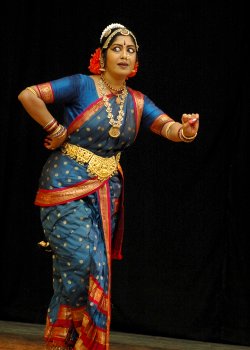 |
 |
Tradition
with a difference
November 17, 2009  Dr.
Alekhya Punjla, who heads the Department of Dance, Telugu University, Hyderabad,
is an outstanding exponent in Kuchipudi and Bharatanatyam styles of dance.
Under the aegis of Bharatham, a cultural organization, her recent solo
performance in Kuchipudi was a wonderful presentation that thrilled the
audience in Thrissur, Dr.
Alekhya Punjla, who heads the Department of Dance, Telugu University, Hyderabad,
is an outstanding exponent in Kuchipudi and Bharatanatyam styles of dance.
Under the aegis of Bharatham, a cultural organization, her recent solo
performance in Kuchipudi was a wonderful presentation that thrilled the
audience in Thrissur,
Trained by the late Dayal Sharan and continuing with Dr. Uma Rao, she has won laurels both at home and abroad. The dancer has traversed the US, UK, Europe and Middle East. Even the traditional becomes innovative both in choreography and in interpretation. Her choreography is a blend of natya dharmi and loka dharmi, with an exhilarating lilting quality to her movements. Abhinaya is her forte: her large expressive eyes showcasing navarasas with her sensuous face a perfect backdrop. The recital began with an invocation to Goddess Saraswathi, a composition of Swami Dayananda Saraswathi in ragam Yaman Kalyan and thripuda thalam. Like a Ravi Varma painting of Saraswathi come alive, the dancer transforms herself into the goddess. Then we see the human aspect, a dancer-devotee, and a stunned poet who sings, forgetful of everything around. Indeed dance traditions in India have borrowed the Sanskrit descriptive narrative style to create visuals. It was followed by Rama Pattabhishekha Sabdam, ragam Mohanam, thalam adi. The story of Lord Rama from his childhood to coronation flitted past in a racy flavor, the sahitya interpolated with jathis. The highlight of the piece, however, was in the format of a question-answer between the nattuvanar and the dancer; the rhythm of sound and that of the dance-movements, especially the foot work, composed by the late Vedantam Jagannadha Sarma. The third item was Daruvu from Sankarapallaki Seva Prabhandam of Maharashtra King Shahaji who ruled Tanjore, in ragamalika and adi thalam. Lord Siva sat resplendent in his Sabha, adorned by other devas. Siva stuthi presented the magnificent Lord enveloped in spiritual aura, the epitome of the Siva cult that ruled the sub continent. The fourth piece was a traditional Tharangam in Mohana ragam and adi thalam. A blend of nritta, nritya and natya in lucid sanchari bhavas recreated the antics of child Krishna with a difference. Krishna is portrayed as the incarnation of the spirit of mischief, the naughty child in the hands of a doting mother. He refuses to sleep when put to sleep. Then he falls asleep only to wake up when the mother tip toes to do her chores. He says he is hungry but is not willing to eat. Exasperation and devotion vie with each other in the mother-child relationship. Then comes the boy Krishna, grown up to gang up with other kids, leading them in unimaginable pranks. Instead of the usual narratives from Jayadeva, we see a boy who plays marbles; quarrels with other children; plays alone; always an inventor of mischief. Yes, he can take a perfect aim: his stone shatters the pot of the woman who carries buttermilk over her head. Yasoda listens to a list of complaints that each mother still finds difficult to cope with. Tradition is a continuing saga in the life of an Indian woman despite modernity and toys. The real and the poetic weave its magic as the dancer narrates tales told, retold, and untold. After a break, Sringara bhava dominated. An Annamacharya sankeerthanam presented the bashful feminine ethos, an aspect of the Indian ideal. Alamelumanga emerging from the bridal chamber aghast at the sun already up is waylaid by her teasing friends trying to question her. The tell-tale signs of revelry, emotions that are sacred to a woman, her studied silence that rouses the imagination of her friends emerge in aesthetic dimensions in the descriptive narrative, in natural style in ragam Thillang, roopaka thalam. The next item was a Swathi Thirunal composition in Hindi, in Sumanasa Ranjani ragam, thalam Adi. "Let's go to Brindavan..." Here a Gopika persuades her friend to accompany her to Brindavan. Once again the presentation acquires poetic dimensions. Brindavan becomes a symbol that each woman carries in her dreams where Krishna, the eternal lover, with his flute weaves the enchantment of love. The dancer vividly paints Brindavan rich in flora and fauna, animated Nature ripe for fruition. Longing is the dominant mood created. The concluding piece was a salutation to the Mother goddess. The dance in praise of Devi showcased Alekya's talent in abhinaya with Karuna and Raudra crowning the enactment, in Misra Sivaranjani and thripuda thalam. The lighting effects cast a haloed twilight. The orchestral
support enhanced the rare chemistry between the music and the dance: Vocal
- Chandra Rao, nattuvangam - R Vinod Kumar, mridangam - Sreedharacharya,
flute - VBS Murali, violin - Anil, veena - Sudhakar.
Padma Jayaraj is a freelance writer and a regular contributor to www.narthaki.com |